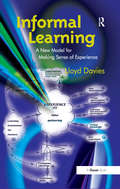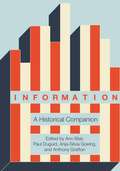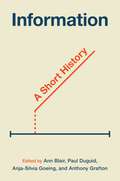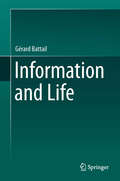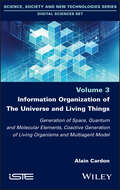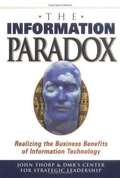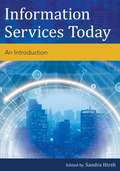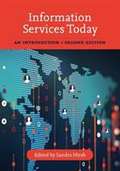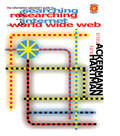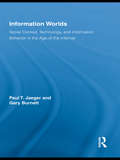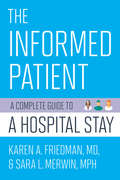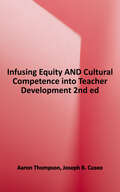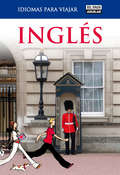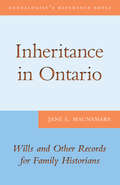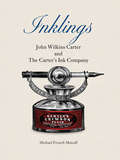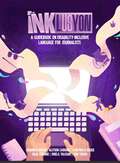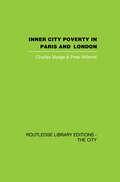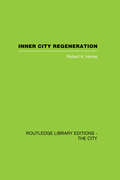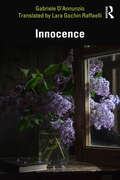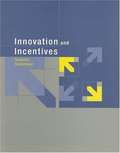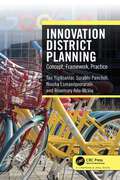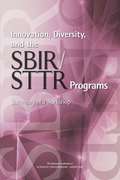- Table View
- List View
Informal Learning: A New Model for Making Sense of Experience
by Lloyd DaviesIn much of the developed world, learning is synonymous with the formal, structured processes that involve teachers, lecturers or trainers. Yet it is experience that is by far the most influential teacher that any of us will have, from the very first moment we are born. Lloyd Davies puts forward a new way of looking at experiential learning; a model that identifies the elements, and points to some of the dynamics. The book highlights the characteristics that are common to the learning process, explains how we learn from experience and why each of us sees our experiences in different ways and, consequently, learns different lessons. It provides advice and guidance on how each of the various elements of the process can be used to greater effect, both for individual and group learning, as well as in mentoring and counselling. The book, which is based on the author's research, is written for a wide readership that includes both learning practitioners and students. If individuals and the organizations within which they work, as students or as employees, understand the basis on which they learn and can turn the process from a passive to an active one, the implications for their development are profound. Lloyd Davies' model for Informal Learning provides a relevant, flexible and significant tool that can offer a sea-change in the way we all learn.
Information: A Historical Companion
by Ann Blair, et al.A landmark history that traces the creation, management, and sharing of information through six centuriesThanks to modern technological advances, we now enjoy seemingly unlimited access to information. Yet how did information become so central to our everyday lives, and how did its processing and storage make our data-driven era possible? This volume is the first to consider these questions in comprehensive detail, tracing the global emergence of information practices, technologies, and more, from the premodern era to the present. With entries spanning archivists to algorithms and scribes to surveilling, this is the ultimate reference on how information has shaped and been shaped by societies.Written by an international team of experts, the book's inspired and original long- and short-form contributions reconstruct the rise of human approaches to creating, managing, and sharing facts and knowledge. Thirteen full-length chapters discuss the role of information in pivotal epochs and regions, with chief emphasis on Europe and North America, but also substantive treatment of other parts of the world as well as current global interconnections. More than 100 alphabetical entries follow, focusing on specific tools, methods, and concepts—from ancient coins to the office memo, and censorship to plagiarism. The result is a wide-ranging, deeply immersive collection that will appeal to anyone drawn to the story behind our modern mania for an informed existence.Tells the story of information’s rise from 1450 through to todayCovers a range of eras and regions, including the medieval Islamic world, late imperial East Asia, early modern and modern Europe, and modern North AmericaIncludes 100 concise articles on wide-ranging topics:Concepts: data, intellectual property, privacyFormats and genres: books, databases, maps, newspapers, scrolls and rolls, social mediaPeople: archivists, diplomats and spies, readers, secretaries, teachersPractices: censorship, forecasting, learning, political reporting, translatingProcesses: digitization, quantification, storage and searchSystems: bureaucracy, platforms, telecommunicationsTechnologies: cameras, computers, lithographyProvides an informative glossary, suggested further reading (a short bibliography accompanies each entry), and a detailed indexWritten by an international team of notable contributors, including Jeremy Adelman, Lorraine Daston, Devin Fitzgerald, John-Paul Ghobrial, Lisa Gitelman, Earle Havens, Randolph C. Head, Niv Horesh, Sarah Igo, Richard R. John, Lauren Kassell, Pamela Long, Erin McGuirl, David McKitterick, Elias Muhanna, Thomas S. Mullaney, Carla Nappi, Craig Robertson, Daniel Rosenberg, Neil Safier, Haun Saussy, Will Slauter, Jacob Soll, Heidi Tworek, Siva Vaidhyanathan, Alexandra Walsham, and many more.
Information: A Short History
by Ann Blair, Paul Duguid, Anja-Silvia Goeing, and Anthony GraftonAn essential guide to the ways information has shaped and been shaped by societiesThanks to recent advances, we now enjoy seemingly unlimited access to information. How did information become so central to our everyday lives? This book traces the global emergence of information practices and technologies across pivotal epochs and regions, providing invaluable historical perspectives on the ways information has shaped and been shaped by societies. Featuring the core articles from the ultimate reference book Information: A Historical Companion, this short history will appeal to anyone seeking to understand our modern mania for an informed existence. The book:Tells the story of information&’s rise from the premodern era to today, exploring how diverse cultures have created, managed, and shared facts and knowledgeTakes readers from the medieval Islamic world to late imperial East Asia, and from early modern and modern Europe to contemporary North AmericaCovers a broad range of topics, such as networks, bureaucracy, publicity, propaganda, censorship, privacy, intellectual property, digitization, telecommunications, storage and search, and much moreIncludes a new introduction, suggested further readings, and a glossary of key termsBrings together an international team of experts, including Jeremy Adelman, Devin Fitzgerald, John-Paul Ghobrial, Lisa Gitelman, Randolph C. Head, Richard R. John, Elias Muhanna, Thomas S. Mullaney, Carla Nappi, Craig Robertson, Daniel Rosenberg, Will Slauter, and Heidi Tworek
Information and Communication Technologies in Tourism 2017
by Roland Schegg Brigitte StanglThis book presents state-of-the-art research into the application of information and communication technologies to travel and tourism. The range of topics covered is broad, encompassing digital marketing and social media, mobile computing and web design, semantic technologies and recommender systems, augmented and virtual reality, electronic distribution and online travel reviews, MOOC and eLearning, eGovernment, and the sharing economy. There is a particular focus on the development of digital strategies, the impact of big data, and the digital economy. In addition to the description of research advances and innovative ideas, readers will find a number of informative industrial case studies. The contents of the book are based on the 2017 ENTER eTourism conference, held in Rome. The volume will be of interest to all academics and practitioners who wish to keep abreast of the latest developments in eTourism.
Information and Life
by Gérard BattailCommunication, one of the most important functions of life, occurs at any spatial scale from the molecular one up to that of populations and ecosystems, and any time scale from that of fast chemical reactions up to that of geological ages. Information theory, a mathematical science of communication initiated by Shannon in 1948, has been very successful in engineering, but biologists ignore it. This book aims at bridging this gap. It proposes an abstract definition of information based on the engineers' experience which makes it usable in life sciences. It expounds information theory and error-correcting codes, its by-products, as simply as possible. Then, the fundamental biological problem of heredity is examined. It is shown that biology does not adequately account for the conservation of genomes during geological ages, which can be understood only if it is assumed that genomes are made resilient to casual errors by proper coding. Moreover, the good conservation of very old parts of genomes, like the HOX genes, implies that the assumed genomic codes have a nested structure which makes an information the more resilient to errors, the older it is. The consequences that information theory draws from these hypotheses meet very basic but yet unexplained biological facts, e.g., the existence of successive generations, that of discrete species and the trend of evolution towards complexity. Being necessarily inscribed on physical media, information appears as a bridge between the abstract and the concrete. Recording, communicating and using information exclusively occur in the living world. Information is thus coextensive with life and delineates the border between the living and the inanimate.
The Information Master: Jean-Baptiste Colbert's Secret State Intelligence System
by Jacob SollJean-Baptiste Colbert saw governance of the state not as the inherent ability of the king, but as a form of mechanical mastery of subjects such as medieval legal history, physics, navigation, and the price lists of nails, sails, and gunpowder. In The Information Master, Jacob Soll shows how the legacy of Colbert's encyclopedic tradition lies at the very center of the rise of the modern state. This innovative book argues that Colbert's practice of collecting knowledge originated in Renaissance Italy, where merchants recognized the power to be gained from merging scholarship and trade. By connecting historical literatures--archives, libraries, merchant techniques, and humanist pedagogy--that have usually remained separate, Soll has created an imaginative and refreshing work.
Information Organization of the Universe and Living Things: Generation of Space, Quantum and Molecular Elements, Coactive Generation of Living Organisms and Multiagent Model
by Alain CardonThe universe is considered an expansive informational field subjected to a general organizational law. The organization of the deployment results in the emergence of an autonomous organization of spatial and material elements endowed with permanence, which are generated on an informational substratum where an organizational law is exercised at all scales. The initial action of a generating informational element produces a quantity of basic informational elements that multiply to form other informational elements that will either be neutral, constituting the basic spatial elements, or active, forming quantum elements.The neutral basic elements will form the space by a continuous aggregation and will represent the substrate of the informational links, allowing the active informational elements to communicate, in order to aggregate and organize themselves.Every active element is immersed in an informational envelope, allowing it to continue its organization through constructive communications. The organizational law engages the active quantum elements to aggregate and produce new and more complex quantum elements, then molecular elements, massive elements, suns and planets. Gravity will then be the force of attraction exerted by the informational envelopes of the aggregates depending on their mass, to develop them by acquisition of new aggregates.The organizational communication of the informational envelopes of all of the physical material elements on Earth will enable the organization of living things, with reproduction managed by communications between the informational envelopes of the elements, realizing a continuous and powerful evolution.
The Information Paradox: Realizing the Business Benefits of Information Technology
by John Thorpe Dmr'S Center For Strategic Leadership StaffThorpe and the experts at DMR Consulting show managers how to measure and maximize the benefits of technology.
Information Services Today: An Introduction
by Sandra HirshThis essential overview of what it means to be a library and information professional today provides a broad overview of the transformation of libraries as information organizations, why these organizations are more important today than ever before, the technological influence on how we provide information resources and services in today’s digital and global environment, and the various career opportunities available for information professionals.
Information Services Today: An Introduction
by Sandra HirshThis essential overview of what it means to be a library and information professional today provides a broad overview of the transformation of libraries as information organizations, why these organizations are more important today than ever before, the technological influence on how we provide information resources and services in today’s digital and global environment, and the various career opportunities available for information professionals. The book begins with a historical overview of libraries and their transformation as information and technology hubs within their communities. It also covers the various specializations within the field emphasizing the exciting yet complex roles and opportunities for information professionals. With that foundation in place, it presents how libraries serve different kinds of communities, highlighting the unique needs of users across all ages and how libraries fulfill those needs through a variety of services, and addresses key issues facing information organizations as they meet user needs in the Digital Age. The book then concludes with career management strategies to guide library and information science professionals in building not only vibrant careers but vibrant information organizations for the future as well.
The Information Specialist's Guide to Searching and Researching on the Internet and the World Wide Web
by Ernest Ackermann Karen HartmanWritten by a professor of computer science and a reference librarian, this guide covers basic browser usage, e-mail, and discussion groups; discusses such Internet staples as FTP and Usenet newsgroups; presents and compares numerous search engines; and includes models for acquiring, evaluating, and citing resources within the context of a research project. The emphasis of the book is on learning how to create search strategies and search expressions, how to evaluate information critically, and how to cite resources. All of these skills are presented as within the context of step-by-step activities designed to teach basic Internet research skills to the beginner and to hone the skills of the seasoned practitioner.
Information Worlds: Behavior, Technology, and Social Context in the Age of the Internet (Routledge Studies in Library and Information Science)
by Paul T. Jaeger Gary BurnettThe authors present a multi-level theory of "Information Worlds" to investigate the ways in which information creates the social worlds of people. Building upon the foundational works of Library and Information Studies (LIS) scholar and theorist Elfreda Chatman and philosopher Jurgen Habermas, as well as from theory and research from a wide range of other fields, the theory of information worlds can serve as a theoretical driver both in LIS studies and across other disciplines that study information issues, enriching and expanding our understanding of the multi-layered role of information in society. Testing their theory through application to a variety of real-world issues, Burnett and Jaeger tackle the topics of libraries and information provision, the value assigned to information by differing social groups, information access and exchange, international information policies, the role of information in democracy, and technological change. Information Worlds provides a framework for empirical investigations into the fascinating and very real social dimensions of information.
The Informed Patient: A Complete Guide to a Hospital Stay (The Culture and Politics of Health Care Work)
by Karen A. Friedman Sara L. MerwinEven the most capable individuals are challenged when confronted with the complexity of the modern hospital experience. The Informed Patient is a guide and a workbook, divided into topical, focused sections with step-by-step instructions, insights, and tips to illustrate what patients and their families can expect during a hospital stay. Anyone who will experience a hospital stay—or friends or family who may be in charge of a patient’s care—will find all the help and advice they could need in the detailed sections that cover every aspect of what they can expect.Karen A. Friedman, MD, and Sara L. Merwin, MPH, offer hands-on advice about how patients, health care providers, and medical staff can work together to achieve good outcomes. Through anecdotes, tips, sidebars, and clinical scenario vignettes, The Informed Patient presents ways to enhance and optimize a hospital stay, from practical advice on obtaining the best care to dealing with the emotional experience of being in the hospital.
Infusing Equity and Cultural Competence into Teacher Development
by Aaron Thompson Joseph B. CuseoAs teachers face increasing diversity within their classrooms in learning styles, race, linguistics, and culture, the academic rigor needed to successfully enter college or a career will require them to evolve in order for all students to succeed. <p><p> Infusing Diversity & Cultural Competence into Teacher Education provides educators and future educators with pathways for achieving cultural competence. Placing this crucial competence in the teacher’s toolbox will increase their opportunity and the capacity of ensuring success in and out of the classroom. The tools presented in this book assist the teacher in making gains in closing achievement gaps, building opportunity for all students, building strong pedagogical skills, enhancing curriculum for their diverse students, and constantly assessing all of these areas to ensure they are maintaining their status as the largest contributor to students’ success. <p><p> Infusing Diversity & Cultural Competence into Teacher Education: <p> Defines, describes, and explains why diversity should be part of the formal education process <p>Illustrates student, family, school, and community roles in the learning process. <p>Describes how to incorporate intercultural communication and relationship building skills into curriculum.
Inglés (Idiomas para viajar #Volumen)
by El País-AguilarEl primero de los títulos renovados es el best-seller de esta serie, INGLÉS PARA VIAJAR..., cuyo número de páginas crece y que ofrece ahora unos contenidos mucho más amplios y completos. Recoge todo lo que se necesita para desenvolverse en inglés durante el viaje: una guía de pronunciación inglesa, un resumen gramatical y un manual de inglés básico como introducción a todos los bloques temáticos pensados para resolver situaciones según avanza el viaje (llegada, desplazamientos, alojamiento, restaurantes, ocio, compras, salud, emergencias...). Todos los capítulos tienen, además de introducciones prácticas del país, un vocabulario imprescindible y expresiones habituales, con sus correspondientes transcripciones. La guía concluye con un minidiccionario español-inglés, que contiene todas las palabras de uso habitual en la comunicación diaria.
The Inherent Right of Self-Defence in International Law
by Murray Colin AlderDetermining the earliest point in time at which international law authorises a state to exercise its inherent right of self-defence is an issue which has been debated, but unsatisfactorily reasoned, by scholars and states since the 1960's. Yet it remains arguably the most pressing question of law that faces the international community. This book unravels the legal and factual complications which have obscured the answer to this question. In contrast to most other works, it takes an historic approach by tracing the evolution of the rights, rules and principles of international law which have governed the use of force by states since the 16th century. Its emphasis on self-defence provides the reader with a new and complete understanding of how and why the international legal framework limits defensive force to repelling an imminent threat or use of offensive force which is directed at the territory of a state. Taking an historic approach enables this book to resurrect an understanding of the human defensive instinct which has guided the formation of the international law of self-defence. It also explains the true legal nature and scope of the inherent right of self-defence, of anticipatory self-defence and provides a definition of the legal commencement of an armed attack for the purpose of Article 51 of the Charter. Finally, the reader will receive a unique source of research materials and analysis of state practice and of scholarly works concerning self-defence and the use of force since the 16th century, which is suitable for all readers of international law around the world.
Inheritance in Ontario: Wills and Other Records for Family Historians
by Jane E. MacnamaraA guide to researching your family’s inheritance history in Ontario. Whether your ancestor left hundreds of acres of land, money, or a few modest belongings, the records created when those legacies were distributed can provide valuable clues to family connections, relationships, and just how your ancestors lived.Inheritance in Ontario will help you determine whether your relative’s will was proved in the Court of Probate, surrogate courts, or another court, and navigate the finding aids to locate surviving estate files and other complementary records at the Archives of Ontario, local courthouse or archives, or through FamilySearch.org. Not every Ontario estate was handled by a court, however, and land records, newspapers, and manuscript collections can also help you discover "who got what."
Inklings: John Wilkins Carter And The Carter's Ink Company
by Michael French MetcalfInklings: John Wilkins Carter and The Carter’s Ink Company is the story of an old New England family and the companies they created and operated—beginning with Timothy Carter’s Old Corner Bookstore in downtown Boston and spanning a 150-year period. The focus of the book is The Carter’s Ink Company, which originated in Boston after the Civil War and prospered until 1976. The story also encompasses James Carter’s paper business in Boston and Nashua, NH. An in-depth look into the Carter’s family is woven throughout and shows how their devout faith served as the backbone for their commitments to business, their communities, and to their fellow mankind.
INKlusyon: A Guidebook on Disability-Inclusive Language for Journalists
by Channele Reynaldine Y. Beros Jean Allyson F. Cabigao Jean Paula B. Roque Julia Theresa L. Soriano Shiela Mae M. Talusan Toni Ysbel Dg"INKlusyon: A Guidebook on Disability-Inclusive Language for Journalists" is a comprehensive resource aimed at fostering sensitivity and respect in media reporting on disability-related issues. Authored by a team of journalism students, the guidebook provides valuable insights into the use of appropriate language when covering stories involving persons with disabilities. It emphasizes the importance of avoiding outdated and offensive terms, while promoting inclusivity in media narratives. The guidebook also explores various disability models and provides journalists with tools to navigate ethical considerations when reporting on the disability sector. Through its detailed chapters, it aims to reshape how disabilities are portrayed in media, ensuring that persons with disabilities are represented with dignity, respect, and accuracy.
Inner City Poverty in Paris and London
by Charles Madge Peter WillmottBoth the great cities studied in this book are renowned for their imposing streets and buildings, their cultural and political vitality and their cosmopolitan lifestyles, but just outside their centres are neighbourhoods where ordinairy people have their homes, often living in poverty and sometimes in squalor. Two such neighbourhoods were Stockwell in London and Folie-Mericourt in Paris, and are the tale of this 'tale of two cities' told by social researchers. The local studies are set in their broader metropolitan and national contexts, including an examination of changes over time in income patterns in France and Britain and in housing policies in the metropolitan regions. This illuminates the effects of different social policies adopted by Britain and France, Paris and London, to help poor and disadvantaged families. This book was first published in 1981.
Inner City Regeneration
by Robert K. HomeThis book covers all the main aspects of government policy and practice in British inner city regeneration. Chapters deal with the development of policy, agencies for regeneration, housing, social issues. The UK edxperience is compared with that of other countries, particularly the USA, and past achievements and future prospects are considered. This book was first published in 1982.
Innocence
by Gabriele D'AnnunzioLara Gochin Raffaelli has produced an expert new English translation of a masterpiece of Italian literature. L'Innocente (1892) is a psychological novel by the renowned Italian author Gabriele D'Annunzio.Set in fin-de-siècle Rome and the southern Italian countryside, the story revolves around Tullio Hermil, a man entangled in his own moral failings. The novel delves into the psychological nuances of the characters and their relationships, making it an exploration of human emotions and moral dilemmas. D'Annunzio explores the depths of Tullio's psyche, exploring his twisted emotions, moral ambiguity, and descent into madness. The translation is faithful to D’Annunzio’s original, maintaining his lyrical rhythms and rich imagery, while updating previously censored content for modern readers. Key themes include the interplay of religious faith and the pursuit of sensual pleasure; the implications of patriarchal authority; and the pursuit of redemption in a morally ambiguous worldInnocence presents an uncensored version of Gabriele D’Annunzio’s famous novel. Also, featuring a rich and informative introduction from Michael J. Subialka, the novel is a valuable contribution to the fields of comparative literature, Italian studies, fin-de-siècle studies, and medical humanities.
Innovation and Incentives
by Suzanne ScotchmerInterest in intellectual property and other institutions that promote innovation exploded during the 1990s. Innovation and Incentives provides a clear and wide-ranging introduction to the economics of innovation, suitable for teaching at both the advanced undergraduate and graduate levels. It will also be useful to legal and economics professionals. Written by an expert on intellectual property and industrial organization, the book achieves a balanced mix of institutional details, examples, and theory. Analytical, empirical, or institutional factors can be given different emphases at different levels of study. Innovation and Incentives presents the historical, legal, and institutional contexts in which innovation takes place. After a historical overview of the institutions that support innovation, ranging from ancient history through today's government funding and hybrid institutions, the book discusses knowledge as a public good, the economic design of intellectual property, different models of cumulative innovation, the relation of competition to licensing and joint ventures, patent and copyright enforcement and litigation, private/public funding relationships, patent values and the return on R&D investment, intellectual property issues arising from direct and indirect network externalities, and globalization. The text presents technical and abstract analysis and at the same time sheds light on current controversies and policy-relevant topics, including the difficulty of enforcing copyright in the digital age and international protection of intellectual property.
Innovation District Planning: Concept, Framework, Practice
by Tan Yigitcanlar Surabhi Pancholi Niusha Esmaeilpoorarabi Rosemary Adu-McVieThis book aims to fill the knowledge gap on how to plan, develop and manage innovation districts that are competitive in terms of both productivity and quality of living, justifying the massive investment put into place and at the same time doing both in a delicate and harmonious way.There is a need for smart urban land use that is wired with both hard infrastructures (e.g., telecommunication and transport) and soft infrastructures (e.g., diversity and tolerance). The reader learns this knowledge through conceptual expansions for key insights, frameworks for potential and performance assessment and best practices for global innovation districts. The authors begin innovation district planning with the role and effectiveness of planning a branding in the development of innovation districts. The next key topic of place making is recognised as a key strategy for supporting knowledge generation and innovation activities in the contemporary innovation districts. Another important topic is place quality where the reader learns to identify and classify indicators of place quality by studying global innovation districts best practices. The reader also expands their understanding on the classification of innovation districts based on their key characteristics through a methodological approach. The book concludes with district smartness studied through the socio-cultural role played by anchor universities in facilitating place making in innovation districts. Smart campuses, enabled by digital transformation opportunities in higher education, are seen as a miniature replica of smart cities and serve as living labs for smart technology.The book serves as a repository for scholars, researchers, postgraduate and undergraduate students as it communicates the complex innovation district phenomenon in an easy-to-digest form by providing both the big picture view and specifics of each component of that view.
Innovation, Diversity, and the SBIR/STTR Programs: Summary of a Workshop
by Sujai J. ShivakumarThe Small Business Innovation Research (SBIR) and Small Business Technology Transfer (STTR) programs provide federal research and development funding to small businesses. One of the the goals of these programs is to foster and encourage participation by minority and disadvantaged persons in technological innovation. "Innovation, Diversity, and Success in the SBIR/STTR Programs" is the summary of a workshop convened in February 2013 that focused on the participation of women, minorities, and both older and younger scientists, engineers, and entrepreneurs in the SBIR and STTR programs, with the goal of reviewing current efforts to expand the pool of SBIR/STTR-funded researchers and of identifying mechanisms for improving participation rates. This report is a record of the presentation and discussions of the event.
